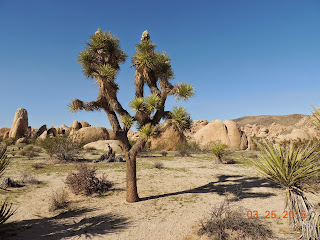Wednesday – March 25, 2015
Joshua Tree National Park
Twentynine Palms, California
We departed Slab City near Niland, California at 9:20 a.m. We arrived at the Cottonwood Spring Campground, in Joshua Tree Natural Park, at 10:45 a.m. The campground is located at an elevation of 3,000 feet, providing for cool nighttime temperatures in the low 60s, with daytime temperatures 10 to 15 degrees lower than the mid-90s temperatures in the valley.
Joshua Tree National Park is located in southeastern California near Twentynine Palms, California. It was declared a U.S. National Park in 1994 when the U.S. Congress passed the California Desert Protection Act, it had previously been a U.S. National Monument since 1936.
The park covers a land area of 790,636 acres, It is named for the Joshua trees, native to the park. It covers a land area of 790,636 acres, an area slightly larger than the state of Rhode Island. A large part of the park, some 429,690 acres, is a designated wilderness area. Straddling the San Bernardino County/Riverside County border, the park includes parts of two deserts, each an ecosystem whose characteristics are determined primarily by elevation: the higher Mojave Desert and lower Colorado Desert. The Little San Bernardino Mountains run through the southwest edge of the park.
The higher and cooler Mojave Desert is the special habitat of the Joshua tree for which the park is named. It occurs in patterns from dense forests to distantly spaced specimens.
In addition to Joshua tree forests, the western part of the park includes some of the most interesting geologic displays found in California's deserts. The dominant geologic features of this landscape are hills of bare rock, usually broken up into loose boulders. The flatland between these hills is sparsely forested with Joshua trees.
Joshua trees dominate the open spaces of the park, but in among the rock outcroppings are Piñon pine, California juniper, Desert Scrub oak, Tucker's oak, and Muller's oak.
Below 3,000 feet, the Colorado Desert encompasses the eastern part of the park and features habitats of Creosote bush scrub Ocotillo, desert Saltbush and mixed scrub including Yucca and Cholla cactus. There are vast areas of Cholla cactus density that they appear as natural gardens.
The lower Coachella Valley is on the southeastern side of the Park with sandy soil grasslands and desert dunes.
The only palm native to California, the California Fan Palm, occurs naturally in five oases in the park, rare areas where water occurs naturally year round and all forms of wildlife abound.
Cottonwood Spring Campground contains 62 campsites, dispersed among two loops; Loop A contains 31 campsites and Loop B contains 31 campsites. Each loop has restroom facilities with flush toilets and potable water spigots. There are no shower facilities available. There is a dump station with two disposal drains. This campground is not suitable for large RV rigs. Our trailer plus tow vehicle measure 34 feet and fit comfortably within one of the largest campsites in Loop B.
Camping Fee: $15.00 (1/2 price with Golden Age Pass)
Camping Site: 9B (Loop B)
Total miles traveled today: 75
Route Traveled:
North on California Highway 111
North on Calfornia Highway 195 to Joshua Tree National Park
Tomorrow another adventure begins.


























No comments:
Post a Comment